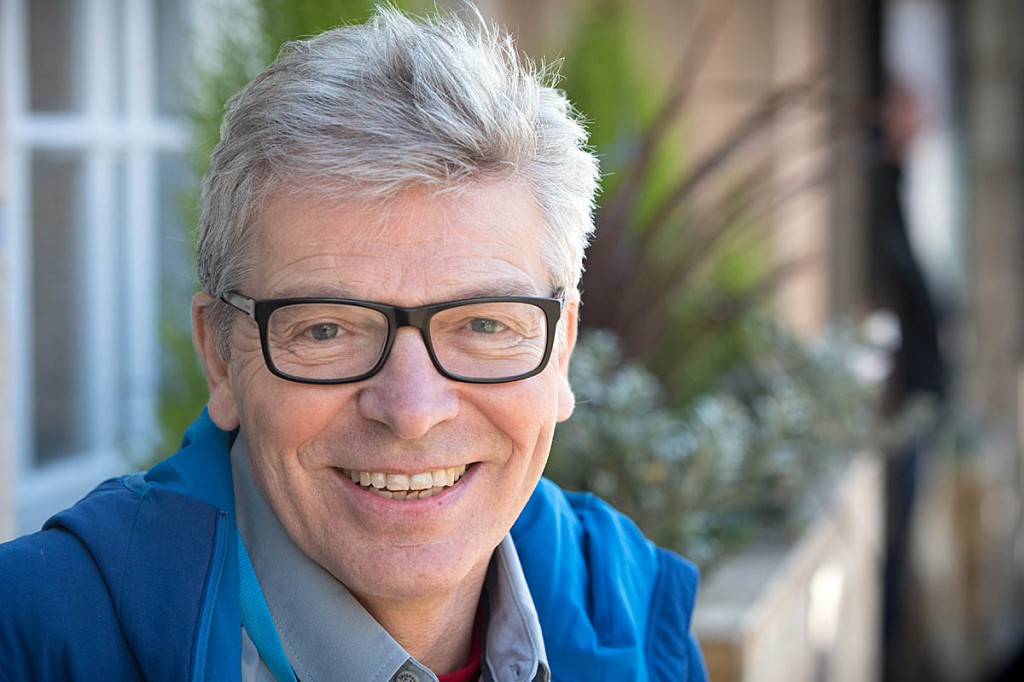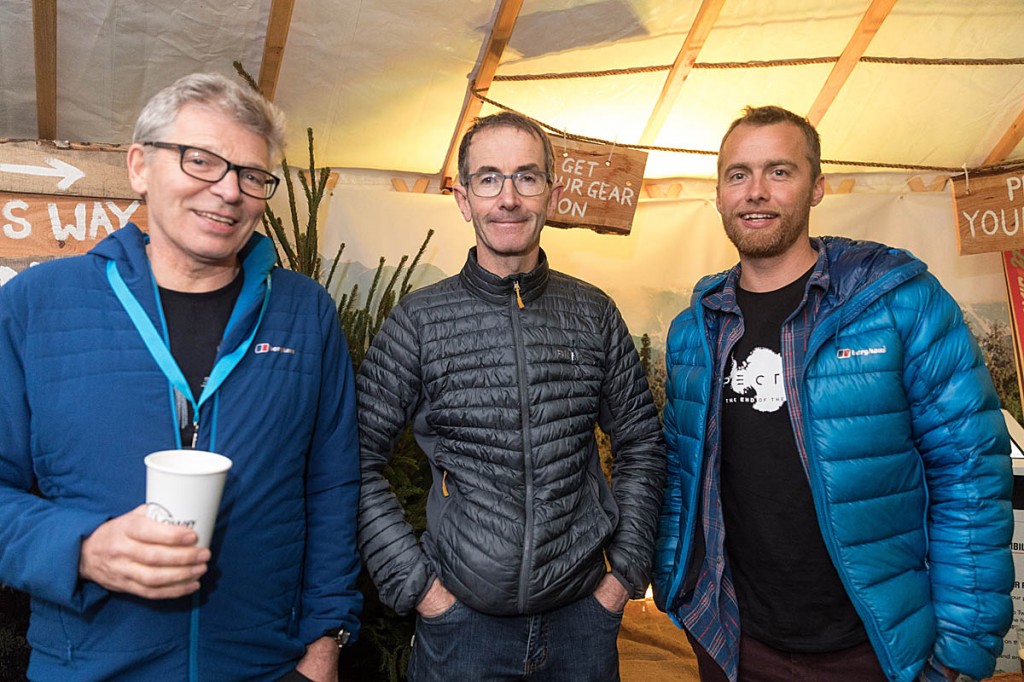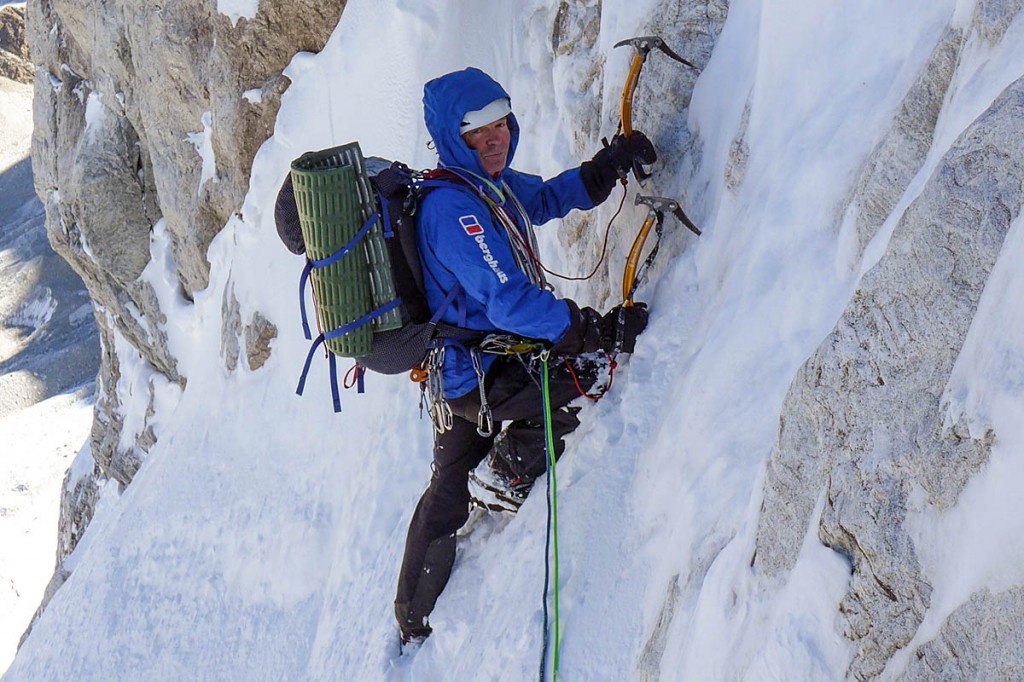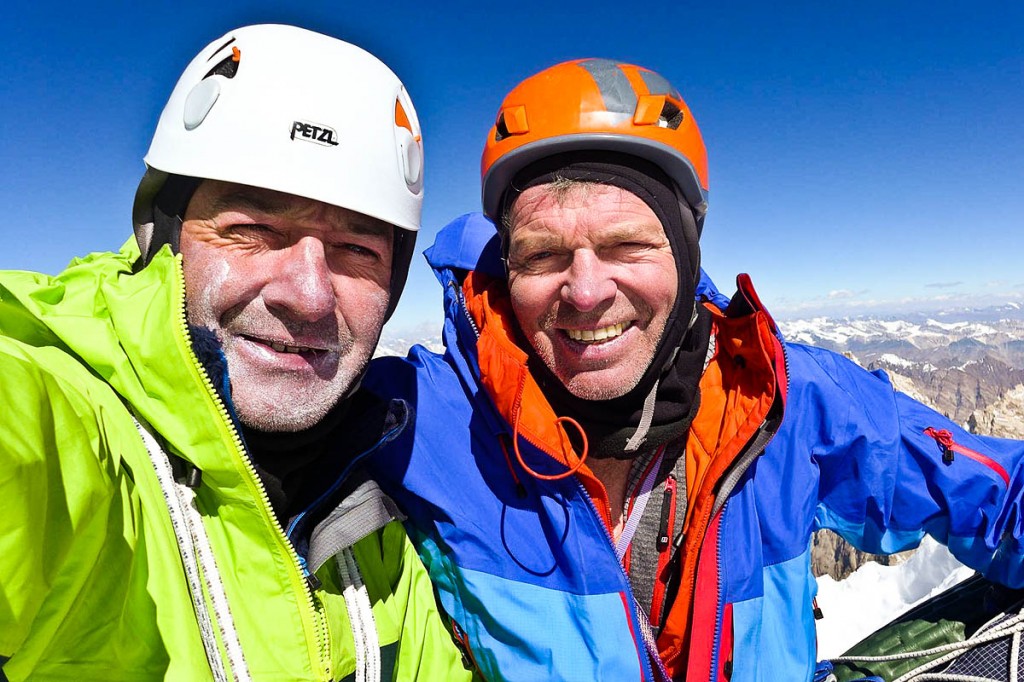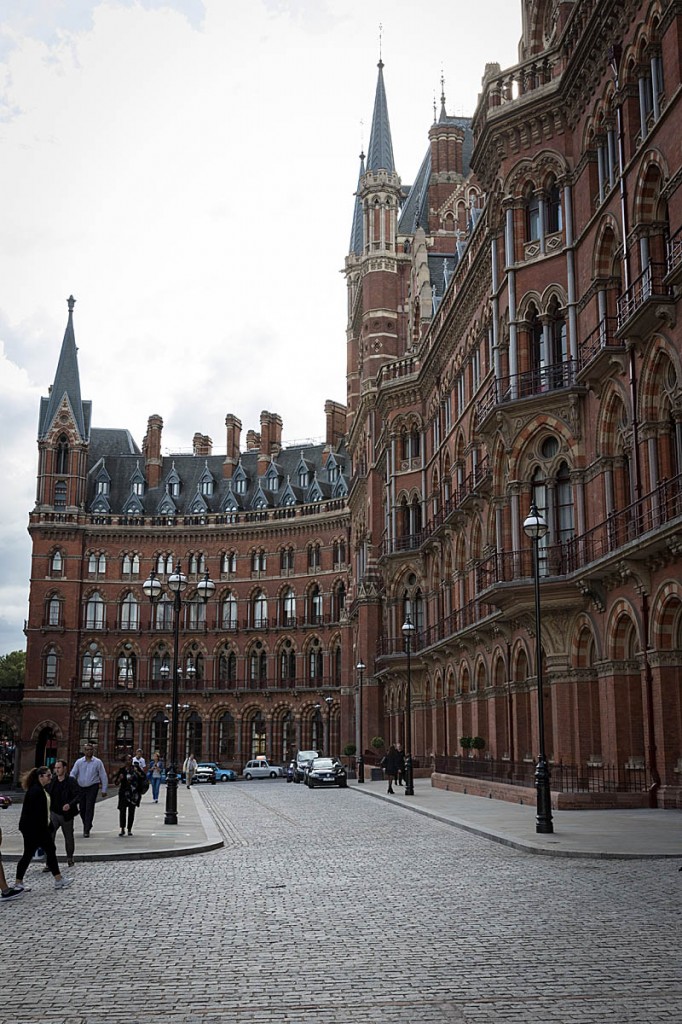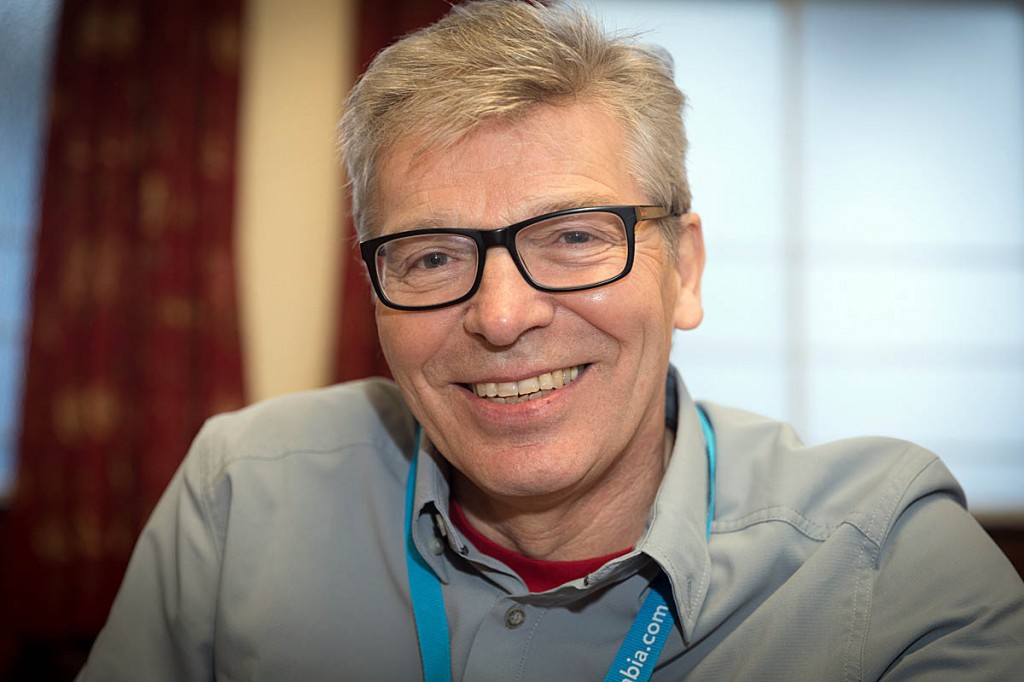He has won the ‘mountaineering Oscar’, the Piolet d’Or three times and has posted numerous first ascents both in Britain and abroad, but 2018 has proved one of the most challenging of Mick Fowler’s life.
The climbing taxman as he is known, was looking forward to spending more time in the outdoors after retiring from Her Majesty’s Revenue and Customs.
A trip to the Himalaya with old mate Vic Saunders was planned for autumn last year. Then Fowler was diagnosed with cancer. And the expedition was put on hold.
After treatment, the Matlock-based climber was given the all-clear to resume climbing and preparations for the venture resumed. But in late summer this year, the 62-year-old was told the cancer had returned.
A major operation to remove part of his digestive system followed and the mountaineer says he is now finally looking forward to embarking on that trip to the Himalaya.
I met up with the quietly spoken Berghaus-sponsored athlete at the recent Kendal Mountain Festival, where he was appearing to promote his new book No Easy Way.
He’s clearly still in pain, especially when sitting down, but seems remarkably sanguine about his recent travails. How is he feeling?
“Hopefully, I’m very good. I managed to complete my second fell race yesterday and I beat two people.” He’s a relatively new convert to fellrunning and took part in the event near Keswick during his sojourn in Cumbria.
“I took up fellrunning originally to keep myself fit for mountaineering,” he says, “but I have become very keen on fellrunning as well as mountaineering, but mountaineering came first.
“I didn’t start fellrunning until about 2009 when someone inspired me to do the annual race on Jura. The race goes over the Paps of Jura and it was a pleasingly slightly eccentric activity, which appealed to me.
“It kept me fit and introduced me to a new circle of mildly eccentric friends.
“There’s quite a crossover between climbing and fellrunning; a lot of my climbing friends to a bit of fellrunning and vice versa.”
Apart from a slight awkwardness in getting into a sitting position, it would be difficult to discern that Fowler was recovering from such a serious illness. He looks well and seems surprisingly chirpy. The previous evening I had seen him reminiscing with fellow Berghaus stablemate Leo Houlding and climber Andy Cave over a beer at the festival.
“I am still recovering. I had the operation to remove my anus and rectum on 8 August and I spent about nine or 10 weeks lying on my back on the settee, researching mountaineering objectives and just closing my mind off to everything.”
Some of the surgical details of his recent experiences are cringe-inducing.
“About 2½ weeks ago, the consultant said: ‘You will not damage your body by exercising now. You can squat right down without splitting open.’ And so, at that point, I got off the settee and tried to carry on exactly where I’d left off.
“It’s going well, but I think: it’s a completely new experience; I’ve never had anything like this before so you don’t really know how your body’s going to react. If you break your arm, even if you’ve not broken your arm before, your brain knows what’s going to happen, but I’ve never seen anyone in this situation. It was a big operation – 8½ hours on the operating table – so I really don’t quite know how I’m supposed to feel.
“I felt a bit tired. I was running along, thinking I really ought to be going a bit faster, but then I thought, maybe I’m still recovering from this operation, or maybe this is just the effect of having done nothing for 10 weeks.
“In my mind, I feel, I should be doing much better than this. All in all, it’s looking very good. I’m told all the cancer cells have been cut out; there’s a big safety margin around what they cut out. I’m fine; I can climb; I can drive and there’s no reason I won’t be going out to the Himalaya next year.
“I was due to go with Victor Saunders last September and two weeks before we were due to go, the cancer issue first arose. So, that had to be postponed. Everything went well, recovery-wise; I was going back to the Alps last summer; I got the all-clear, so we’d postponed, to go in September 2018, and, would you believe it, about 2½ months before we were due to go, the cancer came back and I had to have the operation, so we had to postpone it again.
“I need my Himalayan fix, so we’re going next April. We don’t broadcast exactly where we’re going in advance but it’s an exciting objective in the Himalaya with Vic Saunders.”
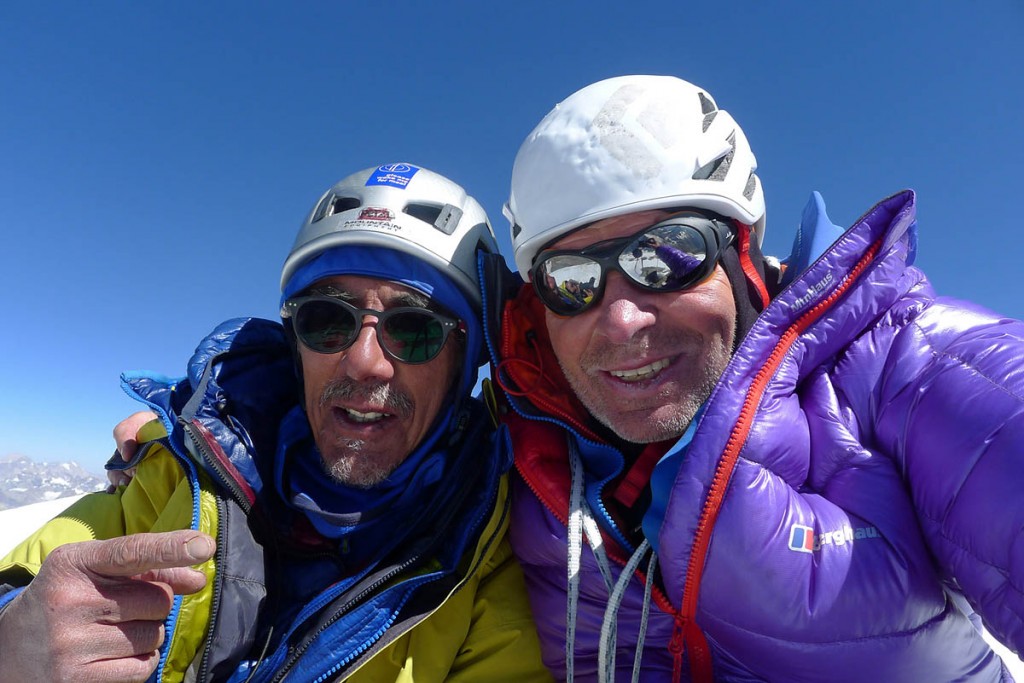
Vic Saunders, left, and Mick Fowler pose for a selfie on the summit of Sersank. Photo: Mick Fowler/Berghaus
It may be a hackneyed question, but when mountaineers push themselves in the environments they do, it’s always interesting to know if they feel they have come close to death. In Fowler’s case, recent events change the nature of the query. “You answered the question for me really,” he says. “What happened with me was, when the cancer came back in July, I had to undergo a series of scans to see whether it had spread such that it would be inoperable.
“I had about a week during which I had to wait for the results of the scan to see whether it was worth trying to save me or not.
“I’m lucky in that I’m a very pragmatic sort of person and I’ve not really been upset and perhaps to some people’s surprise I wasn’t bored lying on my back for 10 weeks on the settee. It just happened and I think, to a certain extent, I sit here now and it’s really uncomfortable, but you get used to things and – shit happens; you deal with it.
“I suppose for me, with that one week aside that I spoke about, the prognosis has always been positive. So the consultant is saying to me now, they’ve done biopsies on all the things they’ve cut out and it’s completely clear. There is no reason why I shouldn’t live a normal life doing exactly what I was doing before.”
On the mountains, his worst experience was in the Indian Himalaya. “There was a close shave on Changabang back in 1997. I like to think we all learnt a lot.
“Basically my climbing partner slipped off the ridge and pulled me off after him and we slid down the snow slope. He broke some ribs. That was by far that was the closest.
“These things remind you it’s important to take care, wherever you are.
“Andy Cave and Brendan Murphy were climbing the same route as us and Brendan Murphy had an abseil accident on the way down and was killed.
“Obviously, that was a terrible experience and gave me a lot of food for thought in terms of choosing objectives in the future and being as careful as one can possibly be.
“Not coming back is not something I would consider. I think you analyse the risks beforehand and clearly, I don’t start climbing if I think there’s a significant risk that’s going to involve me not coming back. That’s not the idea at all; I’m out there to enjoy myself, not to risk my life.
“Inevitably, there are risks involved in mountaineering; I can’t deny that. But you can moderate them to the level where – I suppose everybody does moderate risks in what they do in life – to where they find it to be acceptable, whether you’re a road cyclist, a mountain biker, a skydiver or anything else. We all have our level of risk that we find to be acceptable.”
Fowler has been quoted as saying he likes keeping his fingers and toes and his brain intact, so doesn’t climb above 6,500m.
He corrects me: “7,000m is the limit I’ve set myself. This has very much guided the choice of mountains I climb. It was those thoughts you just mentioned but also to climb mountains higher than that involves taking so much time off work that my work-life balance would have worked.
“I spend an awful lot of my time researching mountaineering objectives with altitudes between 6,000m and 7,000m. The research process has changed hugely, with the advent of things like Google Earth. Traditionally, whenever I saw a photograph – places like the Alpine Club library are packed full of books, and most places in the world, somebody has been there before – so I used to spend a lot of time in the library peering through books and publications and if ever I saw a photograph of a mountain and thought: that looks quite interesting, I’d copy it and put it in my box file of possible objectives and follow it up.
“I’d contact the photographer if they were still alive and find out more about the thing. There are also various research tools like the Himalayan database which is run by the Alpine Club, and I built up a large number of objectives that way.
“It’s surprising how many objectives you find just by going climbing in that particular area. You think: there’s a good striking line on that mountain over there. It’s amazing how much that has influenced what we have done over the year.
“We were climbing on a mountain called Shiva in India and on the skyline was a mountain called Kishtwar Kailash. Before, I hadn’t appreciated what a striking peak it was and it was still unclimbed. In 2012 Paul Ramsden and I were on Shiva and we thought: that looks so impressive; we must go. The next year we went back and managed to climb Kishtwar Kailash as a first ascent.”
“It doesn’t have to be a first ascent of a mountain, but of the feature that I’m climbing. I like the sense of adventure, the sense of exploration, the sense of going where someone’s not been before and the uncertainty that goes with that.
“My tick boxes include going to an area I’ve not been to before, culturally interesting; hopefully a reasonable walk-in to allow me to immerse myself in the culture. There are still some valleys out there where westerners have never been.
“For the objective itself, a striking line, objectively safe, going straight to the summit and with a different descent route – and challenging. The older I get it perhaps doesn’t have to be so technically difficult, but it still needs to be challenging to me.”
Of all his expeditions to the greater ranges, his initial one to the Andes is the one that has stuck in his mind.
“I think the trip that left the deepest impression on me would be my very first one, when I organised a trip out to Peru back in 1982.
“Every step of the way for me was just a huge eye-opening experience.
“I’d never been outside Europe before. I remember we changed planes in Puerto Rico; we got out of the plane and I thought the heat must be coming from the engines. I’d never experienced that kind of temperature.
“We changed planes again in Caracas. It was the time of the Falklands War, and the Venezuelans were on the side of Argentina so our BOAC plane was surrounded by armed guards on the asphalt at Caracas. I remember as a young lad and thinking: what? I’d never really seen anyone with a gun before. The plane then ended up in Bogotá in Colombia and somehow the BOAC flight was not allowed to continue from there because I think Peru was very firmly on the side of the Argentinians, so we were dumped in Bogotá.
“We got an Aero Peru flight to Lima and it genuinely broke down halfway to Lima. There was an announcement in Spanish which we didn’t understand a word of and it was just pandemonium on board.
“The seven of us just sat there with no idea what was happening. It landed on what appeared to be the middle of the desert. There was a chap with a set of stepladders and a headtorch under the engine cowling and they gave up a bucket full of grappa. We just sat there with our legs dangling out of the door, drinking grappa from this bucket.
“Eventually, everyone got back in and it just took off and landed in Lima.
“It just went on and on. In Lima, we just felt so threatened. We tied all our equipment together in the bus station and, just walking round the market, which was quite an ethnically interesting place in those days, I’d just never seen anything like that before.
“There was an open abattoir at the end of the row of shacks. I remember looking and seeing all the shacks had a brown streak running into the river but the one at the end had a bright red streak.
“Further downstream were all the ladies out doing their washing.
“Every step of the way was just amazing. The climbing itself – we just started climbing as we would in the Alps. I’d never been on a route for that long before; we found it difficult. We had four bivouacs on the way up. I’d never had to do that so many times before, yet all the time as we gained height, I can remember it vividly today, you could see on one side of the range down on to the roof of the Amazon rainforest and on the other side there was the coastal desert going out towards the Pacific.
“I just thought: this is an outrageous place to go climbing.
“So, it was the most memorable because it was the first; it was just incredible.”
A lesser first ascent was an implausible one close to home: the west face of St Pancras Station in London, which Fowler thinks took place in 1987. “It was a classic London ice-climb.
“It was quite funny because we’d been up in Scotland and conditions were rubbish. We saw it was really really cold in London and I’d seen this formation when driving past on my way to work at Somerset House.
“I said: let’s get back to London, so we gave up – we drove back from Torridon. There were three parallel drain pipes going up the wall and two of them were completely encased in ice and the right-hand one was not encased in ice and put slings around the support brackets of the other drainpipe for protection.
“It was 65ft high; I know it was because each of the drainpipe sections was 8ft long, so we had eight runners. At the top it was a leaking toilet outflow which was not a very nice ending.”
Had he ever given thought to eschewing the high-adrenaline life of a tax inspector for a full-time occupation as a climber? “I did once, many years ago, consider becoming a climbing instructor.
“I’m very glad, with the benefit of hindsight I didn’t do that. For me personally, I don’t think I would have been as motivated for my own personal climbing. If climbing was my job, I don’t think I would be inspired to go away climbing for my holidays as well.
“The contrast between a tax office life, where I was able to be around at home as well as the family were growing up, and the mountaineering world is one that has worked well for me.
“My motivation when I go mountaineering is enjoying it. I go because I enjoy it; it’s as simple as that.”
Many people must consider the acme of a mountaineering career to be an ascent of Everest. The circus surrounding the tallest peak in the world seems the antithesis of what Fowler seeks in his climbing. Would he ever consider an attempt? “I wouldn’t really regard it as mountaineering,” he says.
“There’s a rope that’s fixed virtually from the bottom to the top. You’re largely in a queue of people and largely being looked after.
“It’s a bit of an extreme package holiday.
“Having said all that, as a mountaineer who has climbed in the Everest region, and seen it there, I can’t deny I felt a sort of feeling it would be nice to stand on the summit one day, but the more I see of the scenes on Everest, the more that thought goes further and further to the back of my mine.
“I can’t honestly see it happening.
“The reason it sits there even as a remote possibility is that I think it would be an unusual and interesting experience and I like unusual and interesting experiences.”
After a career in the tax office during which he used his annual leave to mount the expeditions to the greater ranges, he hopes he finally will have more time for his pursuits.
“I retired in January 2017 and the first two years of retirement have not gone that well.
“So I take the view that retirement is restarting as from when I got off my back 2½ weeks ago. My intention is to do more fellrunning and more rock-climbing, because they are the areas – rock-climbing and winter climbing in the UK – exploratory climbing that I intend to do.
“But there’s also spending more time with the family. My daughter’s out in Australia; our son’s just finishing his university education and there are more things I’d like to do, trips with my wife, that are now possibilities, whereas for the past 25 years there hasn’t been enough time.
“There’s a small group of us in the Peak District who tend to meet up one day a week and do something that involved heavy breathing. In the summer that might be rock-climbing; in winter, caving; it might be biking; it could be running, or if all else fails we’d go to the climbing wall.
“If we went away I tend to go to Scotland or north Wales, but what I’d like to do is get the standard back up again so I can go to some of the more adventurous unclimbed cliffs there still are around our coast.”
He’s also anticipating finally tackling that Himalayan peak that has been postponed twice with Saunders. “We used to climb an awful lot together back in the 1980 when we were both in London.
“We climbed the Golden Pillar of Spantik. He was an architect in London at the time and he gave that all up to become a guide and has been guiding people all round the world. I stayed in the tax office and we got back together for climbing in 2016 and we had a great trip out to India climbing the north face of a peak called Sersank, which was a fantastic trip, a good steep face, an unclimbed peak and it was so good, we said we must do this again.
“Doing it again is now April next year.”
Fowler’s third tome No Easy Way is subtitled the Challenging Life of the Climbing Taxman.
He said: “This book is about my climbing trips over the past 15 years but it’s also about the juggling in life that has to go on to lead that kind of lifestyle, so it also includes a bit about the tax office; about walking the dog – there are a few amusing incidents that have happened; it’s a high-risk activity walking the dog – and I’ve included a bit about the challenges of taking on the presidency of the Alpine Club.
So there’s quite a bit of stuff there that’s not just about mountaineering. Fellrunning features – my introduction, how I became a keen if not competent fellrunner.
Probably the most Fowleresque answer came to the question if, bearing in mind his impressive list of first ascents, it irked Fowler that he wasn’t better known. His reply was a simple: “No.”
No Easy Way is published by Vertebrate Publishing.
